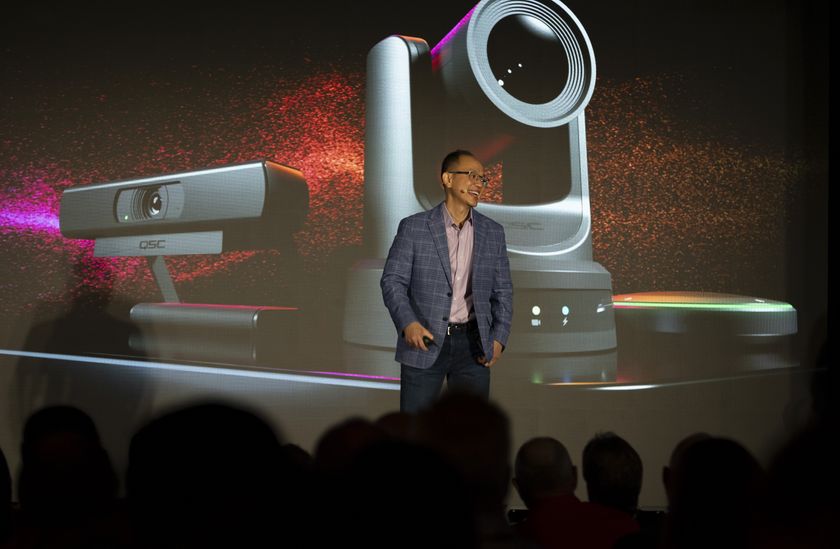Quick Bio

Name: Hilary McVicker
Position: Vice President of Sales and Marketing
Company: The Elumenati
Overtime: McVicker says she is fortunate to live in Asheville and enjoy the beautiful surrounding mountains, but her favorite thing may be a good book on a long flight to a faraway destination. She has a lifelong yoga practice and a gardening addiction. She has served on the board of a local media arts organization and was active in the development of a science museum.
SCN: What is your position, and what does it entail? What are your responsibilities?
HILARY MCVICKER: My job title is communicatrix, which at most companies translates to vice president of sales and marketing. We’re a boutique firm, which means we all get unique job titles, and we all wear several hats. A large part of my role is building and maintaining relationships in both established and new markets. I work directly with clients, both end users and integrators, throughout the sales process. Because our projects are so diverse, this can mean coordinating with our team on everything from design and production to software development and user interface design.
I also manage our sales team, developing strategies and tracking implementation. As one of the owners of the company, I am involved in our discussions on strategy, operations, and product roadmaps. And finally, I manage our branding, website, and outreach.
SCN: How long have you been in this position?
HM: I joined in 2008 to help launch our GeoDome line of turnkey immersive environments. Over the past 12 years, the company and the markets we work in have constantly evolved, so it’s stayed challenging and fresh. I’ve had my current job title since 2011.
SCN: How has your background prepared you for your role?
HM: I came to The Elumenati from the videogame industry, where I developed a passion for the power of interactive storytelling, immersion, and its ability to engage audiences in meaningful ways. Our work at the intersections of entertainment, education, and enterprise is a great fit.
SCN: What are your short- and long-term goals?
HM: This is a critical moment in the adoption of immersive technologies across industries, and it’s my goal to ensure that our systems remain at the forefront. In the long term, I hope to see our technologies leveraged for transformative educational experiences at scale.
SCN: What is the greatest challenge you face?
HM: Well, it’s 2020—where do I start? The impacts of the current global pandemic on our lives, and especially the economy, remain to be seen. Sitting with this uncertainty presents a huge challenge in developing market strategies. More specifically, one of the key features of our immersive environments is the ability to provide group VR experiences in a social, collaborative setting—a hard sell in a moment when gathering together is impossible!
We know that providing headset-free ways to experience immersive content will be a key part of responsible reopening. I would like to think that the new normal will present opportunities as well as challenges.
SCN: Where do you see the projection market heading?
HM: Realistically, we know that LED displays will ultimately displace projection. Whether OLED for small-scale or LED for larger installations, the increase in brightness and contrast over projection is significant. However, that’s matched by an increase in cost, and projection remains a strong solution, especially for mid-range and portable systems.
Compound-curved LEDs have come a long way, so much that we have added them to our product line this year. But spherical displays are still the domain of projection—it remains the only solution for the fill factor required on smaller domes and globes. Projection will also continue to support creative and emerging applications in large-format immersive installations, image mapping on existing surfaces, and transparent displays like Hologauze.
SCN: Are there new initiatives we are likely to see from The Elumenati?
HM: Absolutely. We just launched a new OmniFocus lens and associated family of projection systems. The new 300 series increases image quality and decreases cost—especially in our GeoDomes and internally projected globes. As I mentioned, we’re now offering compound-curved LEDs. We’ve also launched a tool for interactive design review in the AEC sector, and our suite of interactive software solutions continues to evolve to support a broad range of content platforms and user experiences.
Our team’s creative approach to designing user interfaces is something we expect to shine in the coming years. With last year’s Broomstick Flight Trainer, we had great fun proving out multiplayer interactivity in our 360° Cyclorama. While we feel that hands-on and touch-driven interactivity will still have a place in the days to come, we’re expanding our gesture-based offerings and exploring other touchless technologies. We will continue to incorporate new solutions as they emerge.
SCN: How can systems contractors better position themselves to profit from products and/or services you have to offer?
HM: There are a number of ways we can support systems contractors: Our GeoDome line of turnkey systems includes spherical displays to fit any user experience, from globes to domes and panoramas. We also provide components to integrators for use in their own designs, and we create and deploy custom installations.













